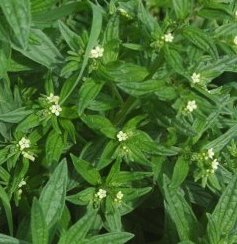Lithospermum

Lithospermum (gromwell) is traditionally used in Chinese medicine to cool blood, stimulate circulation of blood, and eliminate toxins from the skin, lithospermum is considered to be anti-inflammatory, anti-viral, and anti-microbial. Research by pharmaceutical companies has focused on effects of Shikonin, considered to be the key ingredient in Lithospermum, which is showing promise as a protector and stimulant of the immune system and a possible treatment for cancer because of anti-tumor effects.
Shikonin extracted from L. erythrorhizon1 is anti-bacterial, wound-healing, helpful for skin diorders,2 and exerts anti-inflammatory effect via proteasome inhibition.3, 4 Derivatives of Shikonin protect the immune system from damage and support the immune responses in lab animals with tumors.5
Lithospermum erythrorhizon also appears to help suppress high-fat diet induced obesity. Another of its compounds, acetylshikonin inhibits differentiation of adipocytes, cells which are specialized for storing fat. In an animal study, it reduced high-fat induced body weight, adipose tissue mass, triglycerides, and total cholesterol.6
Footnotes
1. Uazaki K. (2017). Lithospermum erythrorhizon cell cultures: Present and future aspects. Plant Biotechnol (Tokyo). 2017;34(3):131-142.
2. Ootsuka Y, Yakazu M, Shimizu T. (1972) Kanpou Shinryou Iten. Nanzandou, Tokyo (in Japanese).
3. Lu L, Qin A, Huang H, Zhou P, Zhang C, et.al. (2011). Shikonin extracted from medicinal Chinese herbs exerts anti-inflammatory effect via proteasome inhibition.
Eur J Pharmacol. May 11;658(2-3):242-7.
4. Ibid. Uazaki. (2017).
5. Long S, GuangZhi Y, BaoJie G, Wei X, YanYong H, et al. (2012). Shikonin derivatives protect organs from damage and
promote immune responses in vivo in tumour-bearing mice. Phytother Res. 2012 Jan;26(1):26-33.
6. Gwon SY, Ahn JY, Chung CH, Moon B, Ha TY. (2012). Lithospermum erythrorhizon suppresses high-fat diet-induced
obesity, and acetylshikonin, a main compound of Lithospermum erythrorhizon, inhibits adipocyte differentiation.
J Agric Food Chem. Sep 12:60(36):9089-96.
 info@naturaleyecare.com
info@naturaleyecare.com



 Home
Home



 Vision
Vision Vision
Vision



 Health
Health Health
Health Research/Services
Research/Services Pets
Pets About/Contact
About/Contact


